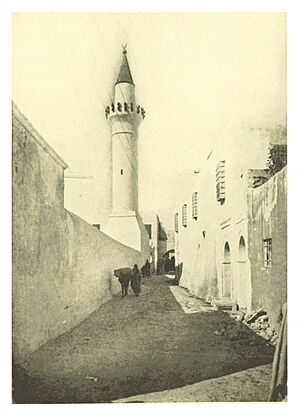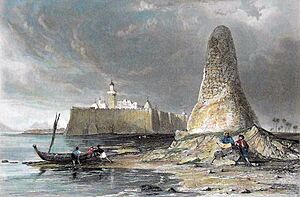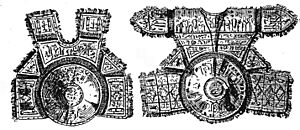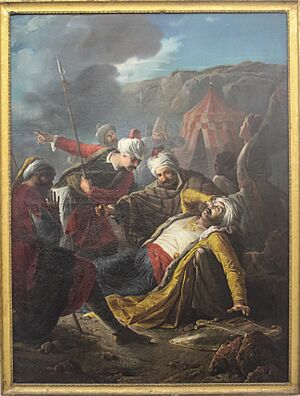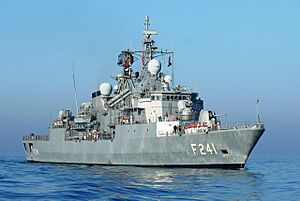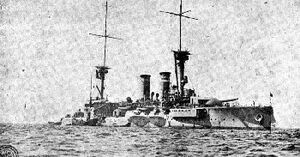Dragut facts for kids
Quick facts for kids
Dragut
|
|
|---|---|
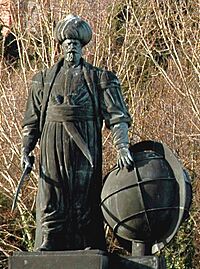
Monument to Turgut Reis in Istanbul
depicted with palm resting on globe |
|
| Native name |
Turgut Reis, "Torghoud"
|
| Nickname(s) | Dragut Rais, Darghouth Arabic: درغوث Italian: Dragura |
| Born | 1485 Karatoprak, Ottoman Empire (modern Turgutreis, Turkey) |
| Died | 23 June 1565 (aged 79–80) Malta (Siege of Malta) |
| Buried |
Sidi Darghut Mosque, Tripoli, Libya
|
| Allegiance | |
| Service/ |
|
| Years of service | c. 1500–1565 |
| Rank | Admiral, Governor-general, Pasha |
| Commands held | Commander-in-Chief of Ottoman Naval Forces in the Mediterranean (Beylerbey) |
| Battles/wars | Battle of Preveza (1538) Sack of Cullera (1550) Invasion of Gozo (1551) Siege of Tripoli (1551) Battle of Ponza (1552) Invasion of Corsica (1553) Sack of Vieste (1554) Sack of Bastia (1555) Raid of the Balearic islands (1558) Battle of Djerba (1560) Sack of Granada (1563) Great Siege of Malta (1565) |
Dragut (also known as Turgut Reis; 1485 – 23 June 1565) was a famous Ottoman corsair, naval commander, and governor. A corsair was like a privateer, a sailor who attacked enemy ships with permission from their government.
Under Dragut's leadership, the Ottoman Empire's naval power grew across North Africa. He was known for his amazing military skills. Many called him "the greatest pirate warrior of all time" and "the uncrowned king of the Mediterranean".
Dragut was nicknamed "the Drawn Sword of Islam". A French admiral described him as "a living map of the Mediterranean". He also said Dragut was "skillful enough on land to be compared to the finest generals". Hayreddin Barbarossa, who was Dragut's mentor, said Dragut was even better than him in some ways.
Dragut served as an Admiral in the Ottoman Navy under Suleiman the Magnificent. He was also appointed as a Bey (governor) of Algiers and Djerba. Later, he became the Pasha (a high-ranking official) of Tripoli. While in Tripoli, Dragut built many impressive structures. He made Tripoli one of the most amazing cities along the North African coast.
Contents
- Dragut's Early Life and Career
- Battle of Preveza
- Governor of Djerba
- Captured and Freed
- Commander of Ottoman Naval Forces
- Beylerbeyi of Algiers
- Sanjak Bey of Tripoli
- Battle of Ponza and Western Mediterranean Campaigns
- Beylerbeyi of the Mediterranean
- Pasha of Tripoli
- Battle of Djerba
- Mediterranean Landings and Sieges
- Siege of Malta and Death
- Legacy
- See also
Dragut's Early Life and Career
Dragut was born in Karatoprak, a village near Bodrum in modern-day Turkey. Today, this town is called Turgutreis in his honor. His family might have been Greek Christians or Turkish Muslims.
When he was about 12 years old, an Ottoman army commander noticed Dragut. He was very talented at using spears and arrows. The commander recruited him, and young Turgut became a skilled sailor. He also became an excellent gunner and master of siege artillery. This skill was very important for his future success as a naval tactician.
In 1517, Dragut went to Egypt. He took part in the Ottoman conquest of Egypt as a cannoneer. He improved his skills in Cairo. After his master died, Dragut joined the fleet of Sinan Pasha in Alexandria. He quickly became a favorite crewman because he was so good at hitting enemy ships with cannons.
Dragut soon became a master sailor. He became the captain of a small ship called a brigantine. After many successful trips, he owned the ship completely. Later, he became the captain and owner of a larger ship called a galliot. He armed it with the best cannons of the time. He began operating in the Eastern Mediterranean, attacking ships that sailed between Venice and the Aegean islands.
In 1520, Dragut joined the fleet of Hayreddin Barbarossa. Barbarossa became his protector and best friend. Dragut was quickly promoted to Chief Lieutenant. He was given command of 12 galiot-class naval vessels. In 1526, Dragut captured the fortress of Capo Passero in Sicily. Between 1526 and 1533, he raided ports in Sicily and Naples. He also captured many ships sailing between Spain and Italy.
In May 1533, Dragut commanded four fustas and 18 barques. He captured two Venetian galleys near the island of Aegina. In 1538, he joined Barbarossa in chasing Andrea Doria in the Adriatic Sea. They captured several fortresses on the coasts of Albania. They also took the Gulf of Preveza and the island of Lefkada. In August 1538, Dragut captured Candia in Crete. He also took other Venetian lands in the Aegean Sea.
Battle of Preveza
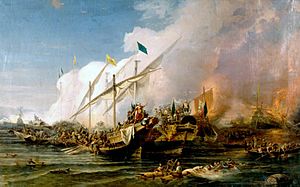
In September 1538, a big naval battle happened at Preveza. Dragut commanded the center-rear part of the Ottoman fleet. He had 20 galleys and 10 galiots. The Ottoman fleet defeated the Holy League. This was a Christian alliance of the Knights of Malta, the Papal States, Venice, Spain, Naples, and Sicily. Their commander was Andrea Doria.
The Holy League had many more ships (302) and soldiers (60,000). But Dragut and the Ottoman fleet, with only 112 ships and 12,000 soldiers, won a great victory. During the battle, Dragut used two of his galiots to capture a Papal galley. He took its commander and crew as prisoners.
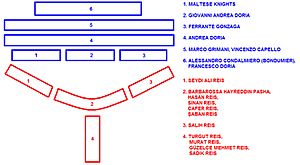
In 1539, Dragut commanded 36 galleys and galiots. He recaptured Castelnuovo from the Venetians. They had taken the city back from the Ottomans. During the fight, he sank two Venetian galleys and captured three others. Also in 1539, he landed on Corfu. He met 12 Venetian galleys and captured one of them. He later landed at Crete and fought against Venetian cavalry.
Governor of Djerba
Later that year, Sinan Pasha became the new Commander-in-Chief of the Ottoman Red Sea Fleet. Dragut was appointed as his successor. He became the Governor of Djerba.
In early 1540, Dragut captured several Genoese ships near Santa Margherita Ligure. In April 1540, he landed at Gozo with 2 galleys and 13 galiots and raided the island. He then raided the coasts of Sicily and Spain with 25 ships. He caused so much damage that Charles V ordered Andrea Doria to chase him with 81 galleys. Dragut then sailed to the Tyrrhenian Sea. He attacked the southern ports of Corsica, like Palasca. He also captured and raided the nearby island of Capraia.
Captured and Freed
Dragut sailed back towards Corsica. He docked his ships at Girolata to repair them. He was surprised in the Battle of Girolata. Dragut and his men were attacked by forces led by Giannettino Doria (Andrea Doria's nephew). Dragut was captured and forced to work as a galley slave for almost four years. He was then imprisoned in Genoa. Barbarossa tried to pay money for his release, but it was refused.
In 1544, Barbarossa returned from France with 210 ships. Sultan Suleiman had sent them to help King Francis I against Spain. Barbarossa appeared before Genoa and surrounded the city. He forced the Genoese to talk about releasing Dragut. Barbarossa met Andrea Doria in his palace. They agreed to release Dragut for 3,500 gold coins.
Barbarossa gave Dragut his own spare flagship and command of several other ships. In the same year, Dragut landed at Bonifacio in Corsica and captured the city. He caused a lot of damage to Genoese interests. Still in 1544, he attacked the island of Gozo. He fought against the forces of knight Giovanni Ximenes. He captured several Maltese ships carrying valuable goods from Sicily. In June 1545, he raided the coasts of Sicily. He attacked several ports on the Tyrrhenian Sea. In July, he attacked the island of Capraia. He landed on the coasts of Liguria and the Italian Riviera with 15 galleys. He raided Monterosso and Corniglia. He also landed at Manarola and Riomaggiore.
In the next few days, he landed at the Gulf of La Spezia. He captured Rapallo, Pegli, and Levanto. In 1546, he captured Mahdia, Sfax, Sousse, and Al-Munastir in Tunisia. He then used Mahdia as a base to attack the Knights of St. John in Malta. In April 1546, he raided the coasts of Liguria. In May, he captured Laigueglia with 1000 men. He also captured Andora and took the town's leader as a prisoner. He and his troops rested there before continuing their attacks on the Italian Riviera. He landed at San Lorenzo al Mare and destroyed the village of Civezza. From there, he sailed to Malta again and surrounded the island of Gozo.
In June 1546, Emperor Charles V ordered Andrea Doria to drive Dragut away from Malta. Doria based his forces at Favignana. But the two admirals did not meet. Dragut had sailed to Toulon in August 1546. He stayed there for several months, letting his men rest safely in a French port.
After Barbarossa died in July 1546, Dragut became the top commander of Ottoman naval forces in the Mediterranean. In July 1547, he attacked Malta again with 23 galleys. He heard that the Kingdom of Naples was having a revolt. This meant Naples would not send naval support to Malta. Dragut landed his troops at Marsa Scirocco, the southern tip of the island. From there, the Ottoman troops quickly marched towards the Church of Santa Caterina. The church guards ran away when they saw Dragut's forces. This stopped them from warning the local people.
After raiding the island, Dragut went to Capo Passero in Sicily. He captured a galley belonging to Giulio Cicala. He then sailed to the Aeolian Islands. At Salina Island, he captured a Maltese trade ship with valuable cargo. From there, he sailed to Apulia. In late July 1547, he attacked the city of Salve. He later sailed to Calabria. This forced the local people to flee to the mountains. From there, he went to Corsica and captured many ships.
Beylerbeyi of Algiers
In 1548, Sultan Suleiman the Magnificent appointed him Beylerbeyi (Chief Governor) of Algeria. In that same year, he ordered a large galley to be built in Djerba. He started using it in 1549. In August 1548, he landed at Castellamare di Stabia near Naples. He captured the city and nearby Pozzuoli. From there, he went to Procida. A few days later, he captured a Spanish galley full of troops and gold near Capo Miseno. He also captured the Maltese galley, La Caterinetta, in the Gulf of Naples. It carried 70,000 gold coins meant for strengthening the defenses of Tripoli.
In May 1549, he sailed to Liguria with 21 galleys. In July, he attacked Rapallo. He then restocked his ships at San Fruttuoso. From there, he sailed to Portofino and landed at the port. He then appeared at San Remo. He captured an Aragonese galley heading to Naples. From there, he sailed to Corsica and then to Calabria. He attacked the city of Palmi.
In February 1550, with 36 galleys, he recaptured Mahdia. He also took Al Munastir, Sousse, and most of Tunisia. In May 1550, he attacked the ports of Sardinia and Spain. He landed on their coasts with 6 galleys and 14 galiots. Also in May, he tried to capture Bonifacio in Corsica but failed. On his way back to Tunisia, he stopped at Gozo to get water and information about the Maltese Knights. He then sailed to Liguria.
In June 1550, while Dragut was sailing near Genoa, Andrea Doria and Bailiff Claude de la Sengle of the Maltese Knights attacked Mahdia in Tunisia. Dragut was busy attacking and raiding Rapallo for a third time. He then raided the coasts of Spain. He sailed to the Tyrrhenian Sea. In early July, he landed on the western shores of Sardinia. He then returned to Djerba. There, he learned that Doria and Claude de la Sengle had been attacking Mahdia and Tunis. He gathered 4500 troops and 60 sipahis. He marched on Mahdia to help the local resistance. He did not succeed and returned to Djerba.
In September 1550, Mahdia surrendered to the Spanish-Sicilian-Maltese forces. Meanwhile, Dragut was repairing his ships at Djerba. In October, Andrea Doria's fleet appeared at Djerba. He blocked the entrance of the island's lagoon, trapping Dragut's ships. Dragut had all his ships dragged over land through quickly dug canals. He used a heavily greased pathway to get them to the other side of the island. He then sailed to Istanbul. On the way, he captured two galleys, one Genoese and one Sicilian.
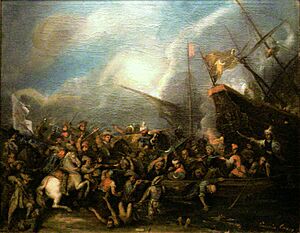
After arriving in Istanbul, Sultan Suleiman ordered Dragut to mobilize a fleet. It had 112 galleys and two galleasses with 12,000 Janissaries. In 1551, Dragut sailed with Ottoman admiral Sinan Pasha to the Adriatic Sea. They attacked Venetian ports, causing serious damage to Venetian shipping.
In May 1551, they landed on Sicily. They attacked the eastern shores, especially Augusta. This was revenge for Sicily's role in invading Mahdia, where many people were killed. They then tried to capture Malta. They landed about 10,000 men at the southern port of Marsa Muscietto. They surrounded the forts of Birgu and Senglea. Later, they went north and attacked Mdina. But they stopped the attack when they realized they could not capture the island with their current number of troops.
Instead, they moved to the nearby island of Gozo. They attacked the citadel for several days. The Knights' governor, Galatian de Sesse, saw that fighting was useless. He surrendered the citadel, and the corsairs raided the town. Dragut and Sinan took almost all the people of Gozo (about 5,000) as prisoners. They sailed from Gozo to Libya. There, they sent the captives to Tarhuna Wa Msalata. They then sailed to Tripoli to conquer the important port city.
Sanjak Bey of Tripoli

In August 1551, Dragut attacked and captured Tripoli. Tripoli was then part of modern Libya. It had been controlled by the Knights of St. John since 1530. Gaspare de Villers, the fort's commander, was captured. Other important knights from Spain and France were also taken.
However, the French ambassador in Constantinople, Gabriel d'Aramon, stepped in. The French knights were released. A local leader, Ağa Murat, was first made governor of Tripoli. But then Dragut himself took control of the area. Sultan Suleiman gave Tripoli and the surrounding land to Dragut. He also gave him the title of Sanjak Bey (Lord of the Standard).
In September 1551, Dragut sailed to Liguria. He captured the city of Taggia. He then captured other ports on the Italian Riviera. Later that year, he returned to Tripoli. He wanted to expand his territory. He captured the entire region of Misrata all the way to Zuwara and Djerba to the west. He also expanded inland to Gebel.
Battle of Ponza and Western Mediterranean Campaigns
In 1552, Sultan Suleiman made Dragut commander-in-chief of the Ottoman fleet. This fleet was sent to Italy as part of a treaty with King Henry II of France. Dragut first landed at Augusta and Licata in Sicily. He then captured the island and castle of Pantelleria. In July 1552, he landed at Taormina. He then attacked and disabled ports on the Gulf of Policastro. He later landed at Palmi and captured the city. He then sailed to the Gulf of Naples to meet with another part of the Ottoman fleet and the French fleet.
Dragut anchored his ships near Formia. He met with Sinan Pasha's fleet. But their French ally did not arrive on time. After waiting, Sinan Pasha decided to return to Constantinople. Dragut convinced Sinan Pasha to join him. Their combined fleet attacked various ports in Sardinia and Corsica. They then captured the island of Ponza.
From there, the Turkish fleet sailed towards Lazio. They attacked ports belonging to the Papal States and the Kingdom of Naples. This happened even though Henry II had promised the Pope that the Ottoman fleet would not harm the Vatican's lands. Because of bad weather, Dragut and Sinan Pasha sailed back to the Gulf of Naples. They landed at Massa Lubrense and Sorrento, capturing both towns. They later captured Pozzuoli and the entire coastline up to Minturno and Nola.
In response, Andrea Doria sailed from Genoa with 40 galleys. He headed towards Naples. When the two fleets first met near Naples, Dragut captured seven galleys. These ships had colonel Madruzzi and many German soldiers on board. The two fleets then went south. On August 5, 1552, Dragut defeated the Spanish-Italian fleet led by Andrea Doria at the Battle of Ponza.
Beylerbeyi of the Mediterranean
After this victory, Sultan Suleiman appointed Dragut Beylerbeyi (Chief Regional Governor) of the Mediterranean Sea.
In May 1553, Dragut sailed from the Aegean Sea with 60 galleys. He captured Crotone and Castello in Calabria. From there, he marched inland. Later, he landed on Sicily and raided most of the island. He stopped at Licata to get water for his ships. In August 1553, he raided the island of Pantelleria. Afterwards, he attacked Sciacca and Modica in southern Sicily. From there, he went to the island of Tavolara and to Sardinia. He then headed towards Porto Ercole and landed on the coast. He then sailed to Elba, where he captured Marciana Marina, Rio, and Capoliveri.
From there, he sailed to Corsica. He took Bonifacio and Bastia for France. France was an ally of the Ottoman Empire at the time. France paid him 30,000 gold coins for the cost of ammunition. Leaving Corsica, Dragut returned to Elba. He tried to capture Piombino and Portoferraio, but gave up. He captured the island of Pianosa. He also recaptured the island and castle of Capri (which Barbarossa had captured in 1535). Then he returned to Istanbul.
In 1554, he sailed from the Bosphorus with 60 galleys. He spent the winter in Chios. From there, he sailed to the Adriatic Sea. He landed at Vieste near Foggia. He captured and raided the city, killing 5000 people. He then sailed towards Dalmatia. He attacked the port of Ragusa (Dubrovnik), the capital of the maritime Republic of Ragusa. In August 1554, he landed at Orbetello and raided the coasts of Tuscany.
The next year, in July 1555, he landed at Capo Vaticano in Calabria. From there, he marched to Ceramica and San Lucido, attacking these cities. He then captured Paola and Santo Noceto. He then sailed to Elba and captured the city of Populonia. He then attacked Piombino. From there, he sailed to Corsica and raided Bastia, taking 6000 prisoners. He later attacked Calvi. He then sailed towards Sardinia and attacked the ports of that island. From there, he turned towards Liguria and landed at Ospedaletti. He captured the city and the coastline around it. He later landed at San Remo before returning to Istanbul.
Pasha of Tripoli
In March 1556, Dragut was appointed Pasha of Tripoli. There, he made the city's walls stronger. He built a gunpowder storage area (Dar el Barud). He also improved the port's defenses. He built the Turgut (Dragut) Fortress where the old Fortress of San Pietro used to be. In July 1556, he sailed again. He landed at Cape Santa Maria on the island of Lampedusa. There, he captured a Venetian ship carrying ammunition and weapons for Malta's defense. He later landed in Liguria and captured Bergeggi and San Lorenzo. In December 1556, he captured Gafsa in Tunisia and added it to his territory.
In the summer of 1557, he left the Bosphorus with 60 galleys. He arrived at the Gulf of Taranto. He landed in Calabria and attacked Cariati, capturing the city. He later landed at the ports of Apulia.
In 1558, he added Gharyan, about 70 miles south of Tripoli, to his territory. He defeated the Beni Oulid dynasty with his soldiers. He added their lands to the Ottoman Empire. He later took Taorga, Misrata, and Tagiora. He then recaptured the island of Djerba and added it to his province. In June 1558, he joined Piyale Pasha's fleet at the Strait of Messina. The two admirals captured Reggio Calabria, raiding the city.
From there, Dragut went to the Aeolian Islands and captured several of them. He then landed at Amalfi, in the Gulf of Salerno. He captured Massa Lubrense, Cantone, and Sorrento. He later landed at Torre del Greco, the coasts of Tuscany, and Piombino. In August, he captured several ships near Malta. In September 1558, he joined Piyale Pasha. The two admirals attacked the coasts of Spain. They then captured Ciutadella (Menorca) and caused a lot of damage to the island's ports.
In 1559, he fought off a Spanish attack on Algiers. He also stopped a revolt in Tripoli. In that same year, he captured a Maltese ship near Messina. He learned from its crew that the knights were planning a big attack on Tripoli. He decided to sail back there and make the city's defenses stronger.
Battle of Djerba
Dragut had made enemies with many rulers in Tunis. Several of them allied with Viceroy Cerda of Sicily. King Philip II of Spain had ordered him to capture Tripoli.
But Philip II's plans failed. The Ottoman fleet of 86 ships, led by Piyale Pasha and Dragut, completely defeated the Christian alliance's fleet of 200 ships. This happened at the Battle of Djerba.
Mediterranean Landings and Sieges
In March 1561, Dragut and Uluç Ali Reis captured Vincenzo Cicala and Luigi Osorio near the island of Marettimo. In June 1561, Dragut landed on the island of Stromboli. In July 1561, he captured seven Maltese galleys. He later freed their commander for a ransom of 3,000 gold coins. After stopping at Gozo for water, he sailed back to Tripoli. In August 1561, he surrounded the city of Naples. He blocked the port with 35 galleys.
In April 1562, he sent scout ships to explore all parts of Malta. Also in 1562, he surrounded Oran, which was controlled by Spain.
In 1563, he landed on the shores of Granada. He captured coastal settlements like Almuñécar, taking 4,000 prisoners. He later landed at Málaga. In April 1563, he helped Salih Reis's fleet with 20 galleys during the Ottoman siege of Oran. He attacked the Fortress of Mers-el-Kebir.
In September 1563, Dragut sailed to Naples. He captured six ships near the island of Capri. These ships carried valuable goods and Spanish soldiers. He later landed at the Chiaia neighborhood of Naples and captured it. From there, he sailed to Liguria and Sardinia, raiding coastal towns. He then sailed to the Adriatic Sea and landed on the coasts of Apulia and Abruzzo. He later landed twice at San Giovanni near Messina with 28 galleys. In October 1563, he sailed towards Capo Passero in Sicily. He later landed once more on Gozo, where he briefly fought against the knights.
Siege of Malta and Death
When Sultan Suleiman ordered the Great Siege of Malta in 1565, Dragut joined Piyale Pasha and the Ottoman forces. He brought 1,600 men (some say 3,000) and 15 ships (13 galleys and 2 galiots; some sources say 17 ships) on May 31, 1565. He landed his troops at the entrance of Marsa Muscietto. This cape was later named after him, 'Dragut Point'.
There, Dragut met Kızılahmedli Mustafa Pasha, the commander of the Ottoman land forces. Mustafa Pasha was surrounding Fort St. Elmo. Dragut advised him to capture the poorly defended Cittadella and Mdina first. But this advice was not followed. Dragut also arranged for more cannon fire on Fort St. Elmo. This fort controlled the entrance of the Grand Harbour and seemed weaker. He added 30 of his own cannons to the attack. In just 24 hours, the Ottomans fired 6000 cannon shots. Dragut realized that Fort St. Elmo and Fort St. Angelo (the Knights' main base) could still communicate. So, Dragut ordered a complete siege of Fort St. Elmo to cut it off from Fort St. Angelo.
On June 18, 1565, Dragut was injured on the head. He was hit by splinters from a cannonball that landed near him. It is not clear if the shot came from Fort St. Angelo or from his own side. Dragut died from his wounds five days later, on June 23, 1565. Many historians believe that if he had lived, the siege would have succeeded. His death caused arguments between the two main Ottoman military officers. This led to bad decisions that helped save the Knights. His body was taken to Tripoli by Uluç Ali Reis. He was buried in the Sidi Darghut Mosque, behind the castle. The mosque is still used today.
Legacy
Dragut is shown in many artworks and statues. Many books have been written about his life and victories. Places and buildings in several countries are named after his Turkish name, Turgut Reis. The town where he was born was renamed Turgutreis in his honor in 1972. Warships of the Turkish Navy and passenger ships have been named after Turgut Reis. He is still very famous and respected in Turkey.
The end of the Tigne area in Malta is called Dragut Point. This is where Dragut set up his first cannons to attack Fort Saint Elmo in 1565. Dragut is seen as a great opponent in Maltese history. "il-Ponta ta' Dragut" is a memorial to the big battles fought there and Dragut's final defeat at the Great Siege of Malta.
See also
 In Spanish: Turgut Reis para niños
In Spanish: Turgut Reis para niños
- List of Muslim military leaders
- Military of the Ottoman Empire




